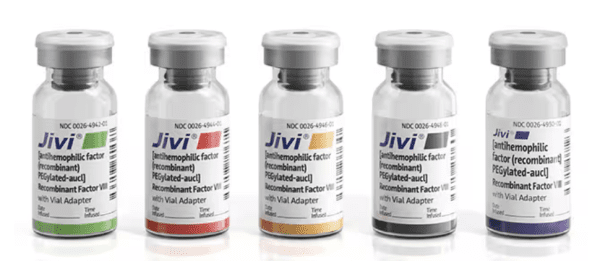Antihemophilic Factor Side Effects
Medically reviewed by Drugs.com. Last updated on Apr 16, 2025.
Applies to antihemophilic factor: intravenous powder for solution.
Precautions
It is very important that your doctor check you or your child closely while you are receiving this medicine to make sure it is working properly. Blood tests may be needed.
This medicine may cause serious allergic reactions, including anaphylaxis, which can be life-threatening and require immediate medical attention. Tell your doctor right away if you have a rash, itching, hoarseness, trouble breathing, trouble swallowing, or any swelling of your hands, face, or mouth after you get the injection.
It is recommended that you carry an identification (ID) card or letter stating that you have hemophilia A and the type of medicine you are using. If you have any questions about what kind of identification to carry, check with your doctor.
Check with your doctor right away if you have any symptoms of parvovirus infection: fever, chills, drowsiness, runny nose, and followed by a rash or joint pain.
Check with your doctor right away if you have pain or tenderness in the upper stomach, pale stools, dark urine, loss of appetite, nausea, unusual tiredness or weakness, or yellow eyes or skin. These could be symptoms of a serious liver problem.
This medicine is made from donated human blood. Some human blood products have transmitted certain viruses to people who have received them, although the risk is low. Human donors and donated blood are both tested for viruses to keep the transmission risk low. Talk with your doctor about this risk if you are concerned.
The stopper of the bottle (vial) contains dry natural rubber (a derivative of latex), which may cause allergic reactions in people who are sensitive to latex. Tell your doctor if you have a latex allergy before you start using this medicine.
Serious side effects
Along with its needed effects, antihemophilic factor may cause some unwanted effects. Although not all of these side effects may occur, if they do occur they may need medical attention.
Check with your doctor immediately if any of the following side effects occur while taking antihemophilic factor:
More common side effects
- fever
Less common or rare side effects
- changes in facial skin color
- chest tightness
- chills
- fast or irregular breathing
- nausea
- puffiness or swelling of the eyelids or around the eyes
- sensation of burning, warmth, heat, numbness, tightness, or tingling
- skin rash, hives, or itching
- trouble breathing
- unusual tiredness or weakness
Incidence not known
- bluish color of the fingernails, lips, skin, palms, or nail beds
- blurred vision
- chest pain or discomfort
- confusion
- cough
- deep or fast breathing with dizziness
- difficult or labored breathing
- difficulty with swallowing
- dizziness, faintness, or lightheadedness when getting up suddenly from a lying or sitting position
- fast, pounding, or irregular heartbeat or pulse
- noisy breathing
- numbness of the feet, hands, and around the mouth
- puffiness or swelling of the eyelids or around the eyes, face, lips, or tongue
- slow or irregular heartbeat
- sweating
- swelling of the face, throat, or tongue
Other side effects
Some side effects of antihemophilic factor may occur that usually do not need medical attention. These side effects may go away during treatment as your body adjusts to the medicine. Also, your health care professional may be able to tell you about ways to prevent or reduce some of these side effects.
Check with your health care professional if any of the following side effects continue or are bothersome or if you have any questions about them:
More common side effects
Less common side effects
Rare side effects
- change in taste
- loss of taste
Incidence not known
- feeling of warmth
- increased sweating
- irritability
- muscle or bone pain
- redness of the eye
- redness of the face, neck, arms, and occasionally, upper chest
- redness of the skin
- stomach pain
- trouble seeing
See also:
For healthcare professionals
Applies to antihemophilic factor: intravenous kit, intravenous powder for injection.
Hematologic adverse events
- Postmarketing reports: Factor VIII inhibition, hemolytic anemia, post-procedural hemorrhage[Ref]
Hypersensitivity
Nervous system
- Postmarketing reports: Generalized tonic-clonic seizure[Ref]
References
1. (2001) "Product Information. Koate-HP (antihemophilic factor)." Bayer
More about antihemophilic factor
- Check interactions
- Compare alternatives
- Reviews (5)
- Dosage information
- During pregnancy
- Drug class: miscellaneous coagulation modifiers
- Breastfeeding
Patient resources
- Antihemophilic factor human drug information
- Antihemophilic factor recombinant
- Antihemophilic factor (Advanced Reading)
- Antihemophilic factor (recombinant) pegylated-aucl (Advanced Reading)
- Antihemophilic factor (recombinant) porcine sequence (Advanced Reading)
Other brands
Advate, Altuviiio, Eloctate, Esperoct, ... +15 more
Professional resources
- Antihemophilic Factor (Human) monograph
- Antihemophilic Factor (Recombinant) (AHFS Monograph)
- Antihemophilic Factor (Recombinant), Fc-VWF-XTEN Fusion Protein-ehtl (AHFS Monograph)
- Antihemophilic Factor (Recombinant), Porcine Sequence (AHFS Monograph)
- Antihemophilic Factor (Recombinant), Single Chain (AHFS Monograph)
Other brands
Advate, Altuviiio, Eloctate, Esperoct, ... +13 more
Related treatment guides
Further information
Antihemophilic factor side effects can vary depending on the individual. Always consult your healthcare provider to ensure the information displayed on this page applies to your personal circumstances.
Note: Medication side effects may be underreported. If you are experiencing side effects that are not listed, submit a report to the FDA by following this guide.

